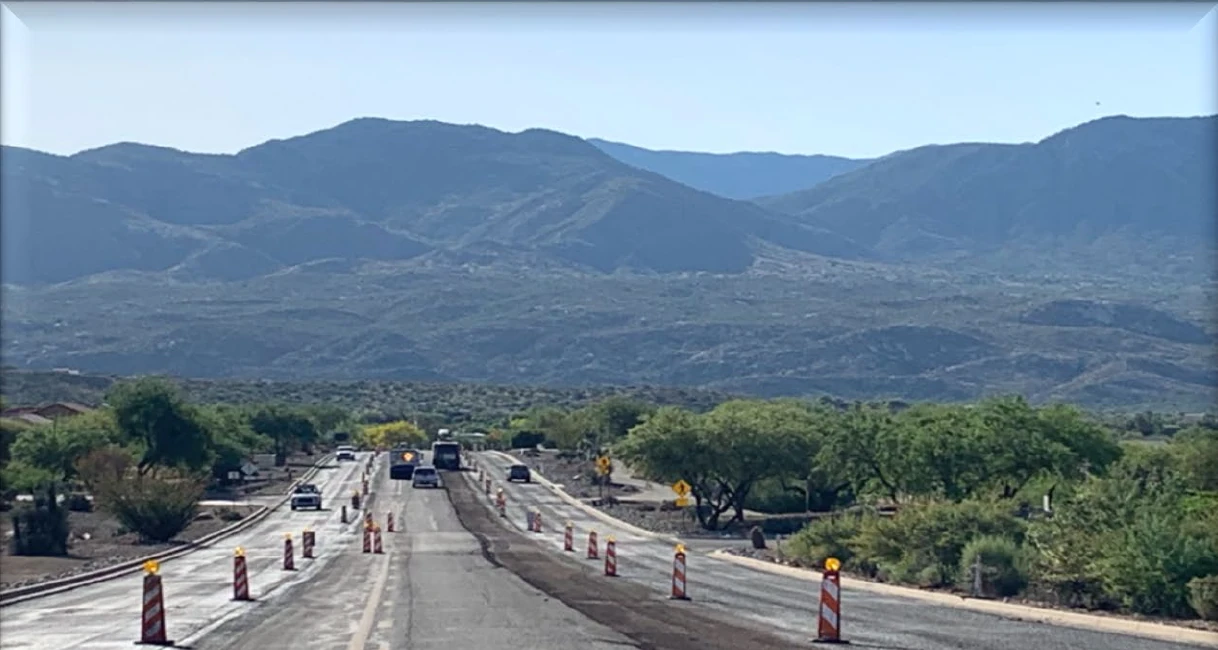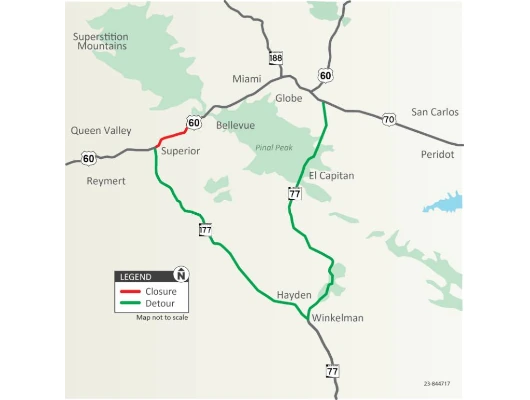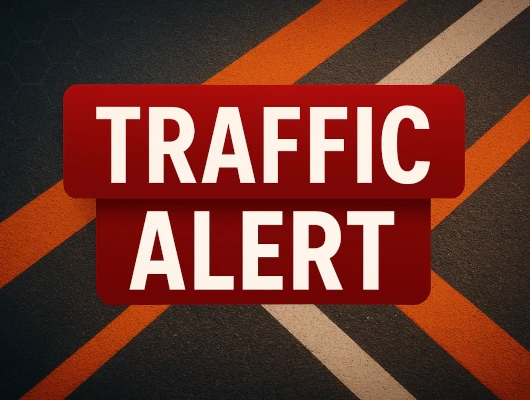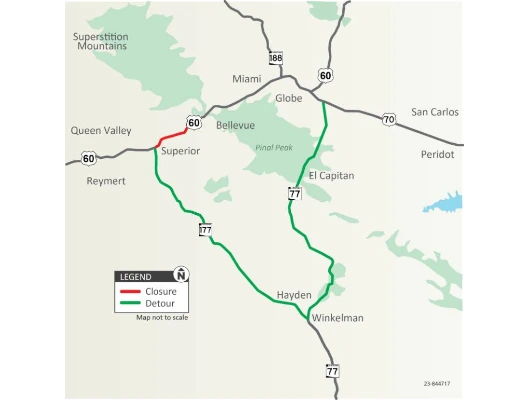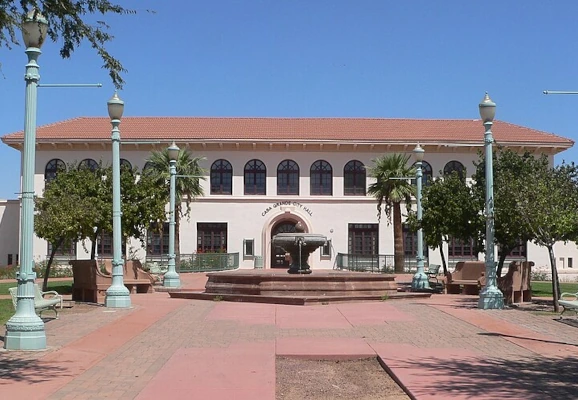Pinal County officials presented the 2025 Five-Year Transportation Improvement and Maintenance Program (TIMP) during a work session on April 16. The presentation outlined projects for Budget Years 2024/2025 through 2028/2029 as recommended by the Transportation Advisory Committee (TAC).
Plan Overview and Funding Timeline
The TIMP serves as Pinal County’s near-term transportation guide, identifying projects for the current, upcoming, and following three budget years. The plan represents a snapshot of project statuses as of February 2025, when the TAC recommended it for approval by the Board of Supervisors.
The plan is primarily funded by the Half-Cent Transportation Excise Tax, which has a significant history in the county:
- Originally approved as Proposition 400 in November 1986, with a sunrise of January 1987 and a sunset of December 2006
- Voters renewed the tax in 2005
- Recently continued as Proposition 486 in November 2024, approved by 77% of voters, extending funding through 2046
“The funding is provided from revenues generated from the Half-Cent Maintenance and Improvement Fund that was originally approved by Pinal County voters in 1986,” Harmon explained during the presentation.
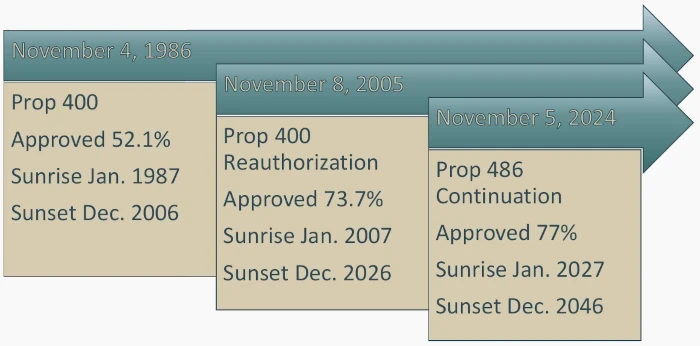
Following the April 16 work session, a 30-day public comment period opened on April 21 and will run until May 20. After addressing all comments, the plan will go before the Board of Supervisors for final approval at their June 18 regular meeting.

Transportation Funding Sources
The county utilizes multiple funding mechanisms for road infrastructure:
Half-Cent Transportation Excise Tax: This voter-approved funding source supports the TIMP with revenues distributed to Pinal County and its ten incorporated cities and towns based on population. Revenue has grown significantly, with projections exceeding $20 million for the current fiscal year.

Highway User Revenue Fund (HURF): Deputy Public Works Director Celeste Garza explained HURF’s importance as a funding source. During the meeting, she stated: “Public Works also operates with highway user revenue funds. So our HURF dollars, those are the 18 cents we get from fuel, when every time you fill up your fuel tank, and as well as your vehicle registration, your vehicle license tax, that’s what generates our HURF dollars. It’s about 18 cents overall, and we get about six of those cents after the state takes their portion for the state highway system.” Most of these HURF dollars fund operations—including labor force and maintenance yards—while a small portion is sometimes set aside for capital projects, such as the State Route 24 corridor.
Local Fuel Purchases Support County Roads
Chairman Miller emphasized the importance of purchasing gas locally. “Buy all your gas in Pinal County. Please. Every drop,” he urged during the meeting.
This appeal is significant because a portion of gas taxes collected in Pinal County returns to local road projects through HURF allocations. When residents buy gas elsewhere, those tax dollars support road projects in other counties instead of benefiting local infrastructure.
Rising Construction Costs Challenge Infrastructure Development
Board Chairman Stephen Miller highlighted how construction costs have dramatically increased since the original gas tax was established.
“The cost of materials, just if you look at that on a graph, it would scare you at what concrete and asphalt cost in ’91 to what it costs today,” Miller noted during the discussion.
Supervisor Mike Goodman provided a specific example: “The interchange there over Ellsworth Road and the 24 cost 38 million bucks…What we’re looking at, the cost of the interchange over Ironwood alone is gonna be roughly about 110 million bucks.”
2025 TIMP Projects and Priorities
Harmon explained the projects planned: “This year, the committee is recommending 30 total projects for budget year 28-29, totaling just over $16 million, with 28 of the projects being new projects and two being static projects. These projects include a bit over $12 million in rehabilitation, reconstruction, recondition or maintenance projects. Nearly $3.7 million in paving or ARDP projects, and $500,000 in safety projects.”
The projects will be distributed across supervisory districts with “a total of six projects within Supervisory District 1, two within District 2, 12 within District 3, seven within District 4, one in District 5, and two projects that are programmed countywide.”
The program’s four key priorities are:
- Roadway maintenance – maintaining existing paved roads
- Traffic flow – reducing congestion on arterial networks
- Paved mileage – increasing paved roads for air quality improvement
- Economic development – supporting infrastructure for economic growth zones
Transportation Advisory Committee Structure
The TAC plays a crucial role in the transportation planning process. The committee consists of ten members appointed by the Board of Supervisors, with two representatives from each of the five supervisory districts.
According to county documentation, committee members must be of legal age and either reside in Pinal County or be employed by a municipality within the county. They serve four-year terms and meet three times per year, with 2026 meetings scheduled for September 16, November 18, and February 17. Harmon noted that “those meetings are open to the public. We do have a public comment period, and we do encourage the public to attend.”
Vice Chair McClure acknowledged that recent redistricting had temporarily created unequal district representation on the committee, but Harmon confirmed that upcoming appointments will restore balance, with each supervisor selecting two representatives.
Public Participation Process
The public can submit transportation project requests year-round via mail, email, or online through the county website. According to Harmon, “Those projects requests submitted on or before September 30th of each year will be considered for inclusion in the fifth year of the program for that upcoming budget year. If the request is submitted after the September 30th cutoff date, it will then be considered for the next budget year.”
Project requests undergo evaluation by district managers who check criteria such as average daily traffic, maintenance and right-of-way statuses, and potential drainage or utility conflicts. Public Works leadership scores eligible projects in eight different categories, including project connectivity, safety improvement, fugitive dust reduction, and maintenance cost reduction.

Plan Flexibility for Emerging Priorities
Several supervisors emphasized that the TIMP remains adaptable to changing priorities. Supervisor Serdy asked if the county could respond quickly to new funding opportunities, particularly regarding major projects like State Route 24.
“This is just a guide, correct? Because in the eastern part of the state, we have some projects that could happen in a hurry with 24 and 505 etc. in which case we have the ability to adapt to that,” Serdy said.
Harmon confirmed the plan’s flexibility, noting, “This is a moving document with a lot of parts, and one of those parts are the amendments. So we do have the ability to amend this document.”
Supervisor Goodman reinforced this point: “This isn’t the limit of what we’re gonna do. These are what, based on our numbers that we have available to us, our budget, this is what we’re gonna do…We’re looking at other avenues that we can come up with revenue to pay for other projects.”
Alternative Funding Mechanisms
The discussion explored several additional funding mechanisms beyond the Half-Cent Tax and HURF funds.
Chairman Miller suggested bonding as another funding approach: “Could we bond a project and use some of these HURF dollars to pay down the bond?”
County Manager Leo Lew confirmed this approach has been used previously: “We could do that. And we have done it in the past, and we have some that are currently in process that we’re continuing to do, like Ironwood and some on Hunt Highway as well.”
Impact fees were also discussed as a potential funding source for certain projects, with officials noting that the county is currently updating its development impact fee structure.
Next Steps for the Transportation Plan
The 2025 TIMP now enters its public comment period, with county officials encouraging residents to review the draft plan and provide feedback through May 20. The Transportation Advisory Committee will then consider these comments before the plan goes to the Board of Supervisors for final approval in June.
With the Half-Cent Transportation Excise Tax secured through 2046 via Proposition 486, Pinal County has established funding stability for its transportation infrastructure. This voter-approved funding, combined with the flexible planning process, positions the county to address ongoing maintenance needs while remaining adaptable to new opportunities and emerging transportation challenges.
The county’s Public Works Transportation Planning webpage offers access to the current and draft five-year plans, TAC meeting materials, project status reports, and a portal for submitting project requests.
